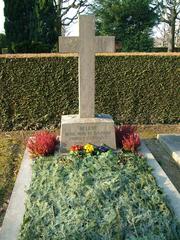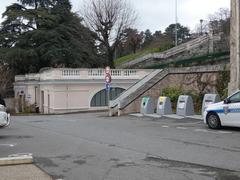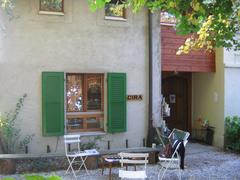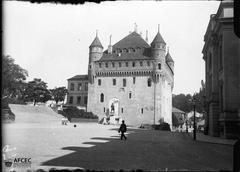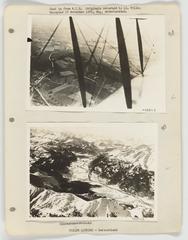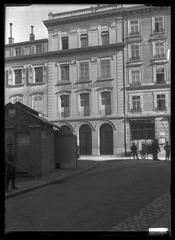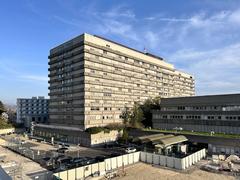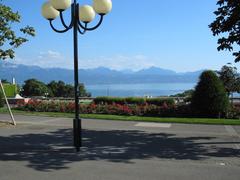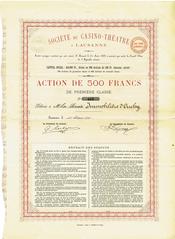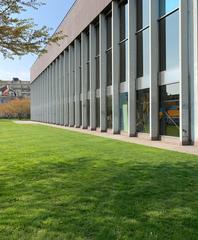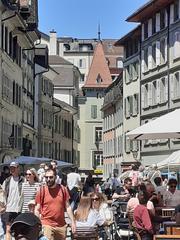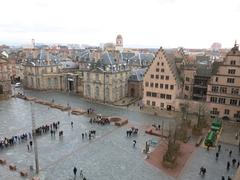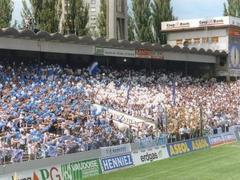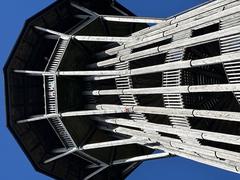Comprehensive Guide to Visiting Tour Haldimand, Lausanne, Switzerland
Date: 25/07/2024
Introduction
Lausanne, a picturesque city in Switzerland, is home to the Tour Haldimand, a historical landmark that offers a unique blend of history, architecture, and natural beauty. Constructed in the early 19th century, the Tour Haldimand is a prime example of neo-Gothic architecture, reflecting the Romantic era’s fascination with medieval ruins. The tower was built as part of an architectural competition among friends, with William Haldimand’s design emerging as the victor (myvaud.ch). Over the years, the tower has been relocated and restored to preserve its historical significance and architectural integrity (Wikipedia).
Today, the Tour Haldimand stands as a cherished landmark in Lausanne, attracting both locals and tourists. It is situated at the eastern end of the Ouchy promenade, a popular waterfront path that offers stunning views of Lake Geneva and the surrounding Alps. The tower’s historical significance is further highlighted by its inclusion in various cultural and historical tours of Lausanne (twosmallpotatoes.com). This guide provides comprehensive information on visiting the Tour Haldimand, including its history, architectural significance, visitor information, and nearby attractions, ensuring a memorable experience for all visitors.
Table of Contents
- History of Tour Haldimand
- Visitor Information
- FAQs
- Modern-Day Relevance
- Related Historical Sites
- Visitor Experience
- Nearby Attractions
- Practical Information
History of Tour Haldimand
Origins and Construction
The Tour Haldimand, a neo-Gothic tower located in Lausanne, Switzerland, has a fascinating history that dates back to the early 19th century. The tower was constructed around 1825 as part of a whimsical architectural competition among three friends - William Haldimand, Auguste Perdonnet, and Charles de Cerjat. The goal of this competition was to build the most convincing romantic ruin in Lausanne. William Haldimand, who owned the Denantou estate, emerged victorious with his picturesque tower, which was initially built almost in the water of Lake Geneva (myvaud.ch).
Architectural Style and Materials
The Tour Haldimand is a prime example of neo-Gothic architecture, a style that gained popularity in the early 19th century as part of the Romantic movement. This architectural style often featured elements reminiscent of medieval Gothic structures, such as pointed arches, ribbed vaults, and flying buttresses. The tower was constructed using blocks of molasse, a type of sandstone, and was originally built on a tuf foundation (Wikipedia).
Relocation and Restoration
In its original location, the Tour Haldimand stood at the eastern mouth of the Vuachère River, on what was then the territory of Pully. However, in 1901, the tower was relocated to its current site due to the filling in of the western bank of the river during the construction of the Quai d’Ouchy. This move was necessary to preserve the tower as the landscape around it changed (Wikipedia).
The tower underwent significant restoration between 1999 and 2001. During this restoration, the thick ivy that had long concealed the tower was removed, and the structure was reinforced with concrete to ensure its stability. This restoration effort was part of a broader initiative to preserve historical monuments in Lausanne (swisscastles.ch).
Cultural and Historical Significance
The Tour Haldimand holds a unique place in Lausanne’s cultural and historical landscape. Its construction was part of a broader Romantic fascination with the Middle Ages, which saw a resurgence of interest in medieval architecture and ruins. This period also marked a shift in public interest towards archaeology and the restoration of abandoned edifices (swisscastles.ch).
The tower’s picturesque appearance and its location by Lake Geneva made it a popular subject for artists and photographers in the 19th century. Notably, the tower was depicted in an 1836 illustration by the British artist William Henry Bartlett, which showcased the tower and the surrounding area of Ouchy (swisscastles.ch).
Visitor Information
Opening Hours
While the Tour Haldimand itself does not have specific visiting hours due to its nature as an open monument, the Ouchy promenade and surrounding areas are accessible 24/7. Visitors can enjoy the scenic views and the historical ambiance at any time of the day.
Ticket Prices
There are no ticket prices for visiting the Tour Haldimand as it is an open monument. Visitors can freely explore the tower and its surroundings without any entrance fees.
Accessibility
The Tour Haldimand is accessible via the Ouchy promenade, a paved pathway suitable for wheelchairs and strollers. The surrounding area is relatively flat, making it easy for visitors of all ages and abilities to enjoy the site.
FAQs
Q: What are the best times to visit the Tour Haldimand?
A: The best times to visit are early morning or late afternoon when the light is perfect for photography and the area is less crowded.
Q: Are there guided tours available?
A: While there are no specific guided tours for the Tour Haldimand, many historical tours of Lausanne include the tower as part of their itinerary. Check with local tour operators for more details.
Q: Is the Tour Haldimand suitable for children?
A: Yes, the Tour Haldimand and the surrounding Ouchy promenade are family-friendly destinations. Children can enjoy the open space, and the scenic views make for a pleasant outing.
Modern-Day Relevance
Today, the Tour Haldimand is a cherished landmark in Lausanne, attracting both locals and tourists. It is situated at the eastern end of the Ouchy promenade, a popular waterfront path that offers stunning views of Lake Geneva and the surrounding Alps. The promenade itself is a testament to Lausanne’s commitment to preserving its natural and historical beauty, making it a must-visit for anyone exploring the city (twosmallpotatoes.com).
The tower’s historical significance is further highlighted by its inclusion in various cultural and historical tours of Lausanne. Visitors can learn about the tower’s origins, its architectural style, and its role in the broader context of Lausanne’s development during the 19th century. The tower’s restoration and preservation efforts also serve as a reminder of the importance of maintaining historical monuments for future generations (lausanne-tourisme.ch).
Related Historical Sites
The Tour Haldimand is part of a trio of towers that were built as part of the same architectural competition. The other two towers are the Tour de Mon-Repos, located behind the Federal Tribunal, and the now-disappeared tower of Rovéréaz, which was situated in the forest of the same name. The Tour de Mon-Repos, constructed between 1821 and 1822, predates the Tour Haldimand by nearly a decade and was designed by the Geneva painter Pierre-Louis Bouvier (Wikipedia).
These towers collectively represent a unique chapter in Lausanne’s architectural history, reflecting the Romantic era’s fascination with medieval ruins and the creative spirit of the city’s residents during the early 19th century. The competition among Haldimand, Perdonnet, and de Cerjat not only resulted in the creation of these picturesque structures but also contributed to the cultural and historical fabric of Lausanne (swisscastles.ch).
Visitor Experience
Scenic Views
For those planning to visit the Tour Haldimand, the tower is easily accessible via the Ouchy promenade. The promenade itself is a scenic route that stretches from the Place de la Navigation at Port d’Ouchy to the tower, offering visitors a leisurely walk along the lake’s edge. The area around the tower is perfect for picnics, photography, and simply enjoying the serene views of Lake Geneva and the Alps (twosmallpotatoes.com).
Accessibility
The Tour Haldimand and its surrounding areas are designed to be inclusive. Most gardens along the shore are accessible by wheelchair or pushchair, ensuring that visitors with reduced mobility can enjoy the scenic beauty without hindrance. However, note that the islands in the lake are only accessible by swimming (Komoot).
Activities and Events
The tower hosts temporary exhibitions and cultural events, offering visitors an opportunity to engage with local culture and history. The area is ideal for picnics and leisurely walks, making it perfect for families and groups seeking a relaxing day outdoors (Komoot).
Best Time to Visit
The best time to visit Tour Haldimand is during spring and summer when the weather is pleasant, and the surroundings are in full bloom. This period coincides with various cultural events and exhibitions, enhancing the visitor experience. However, the tower is accessible year-round, with each season offering its unique charm (Komoot).
What to Bring
Visitors should bring comfortable walking shoes for exploring the trails, a camera for capturing breathtaking views, and a picnic basket for a relaxing outdoor meal. Additionally, it’s advisable to bring water and sun protection, especially during summer (Komoot).
Photographic Spots
Tour Haldimand offers numerous photographic spots, especially from the top of the tower, where you can capture panoramic views of Lake Geneva, Lausanne, and the Alps. The surrounding gardens and pathways also provide picturesque settings for photography (Komoot).
Nearby Attractions
In addition to the Tour Haldimand, visitors can explore other nearby attractions such as the Olympic Museum, the Parc du Denantou, and the Château d’Ouchy. These sites provide a comprehensive experience of Lausanne’s rich history, cultural heritage, and natural beauty (mapcarta.com).
Practical Information
Opening Hours and Admission
Tour Haldimand is open to the public year-round with no admission fee. However, it’s advisable to check for any scheduled events or exhibitions that might affect access. The surrounding area is also open for exploration, providing ample opportunities for outdoor activities (Komoot).
How to Get There
The tower is located in the Lake Geneva region and is easily accessible by public transportation. Visitors can take a bus or train to the nearest station and then enjoy a short walk to the tower. Parking facilities are available nearby for those driving. Detailed directions and transportation options can be found on local tourism websites and maps (Komoot).
Conclusion
The Tour Haldimand is more than just a picturesque tower; it is a testament to Lausanne’s rich historical and cultural heritage. From its origins as a whimsical architectural project to its current status as a beloved landmark, the tower embodies the city’s fascination with medieval architecture and romanticism. Visitors to the Tour Haldimand can enjoy breathtaking views of Lake Geneva and the Alps, explore the scenic Ouchy promenade, and delve into the tower’s storied past (myvaud.ch). The tower’s accessibility and the surrounding area’s family-friendly environment make it an ideal destination for visitors of all ages (swisscastles.ch). Additionally, the nearby attractions, including the Olympic Museum and the Lavaux Vineyards, offer a well-rounded cultural experience (Lonely Planet). Whether you’re a history enthusiast, an architecture aficionado, or simply looking for a scenic spot to relax, Tour Haldimand is a must-visit destination in Lausanne.

